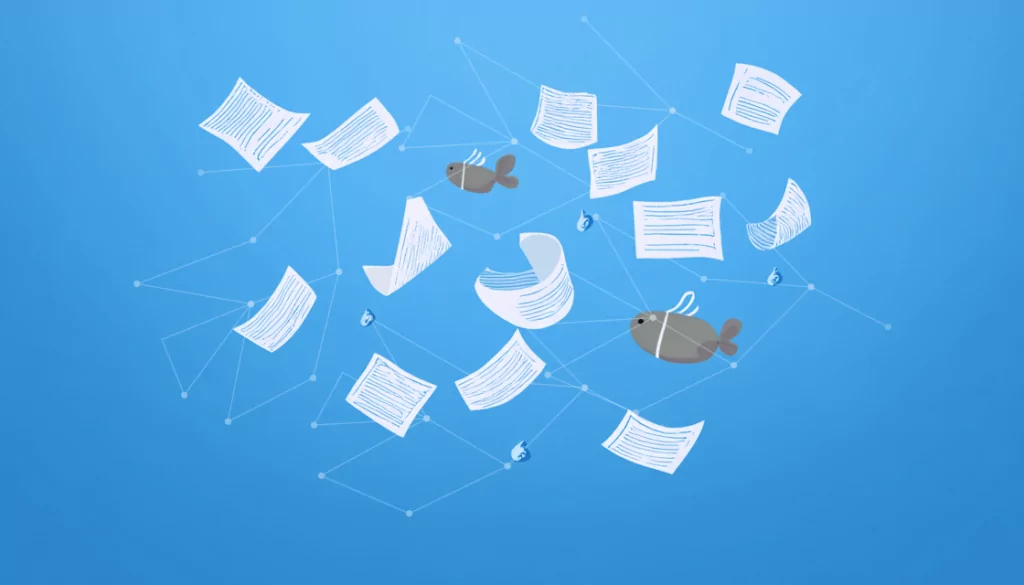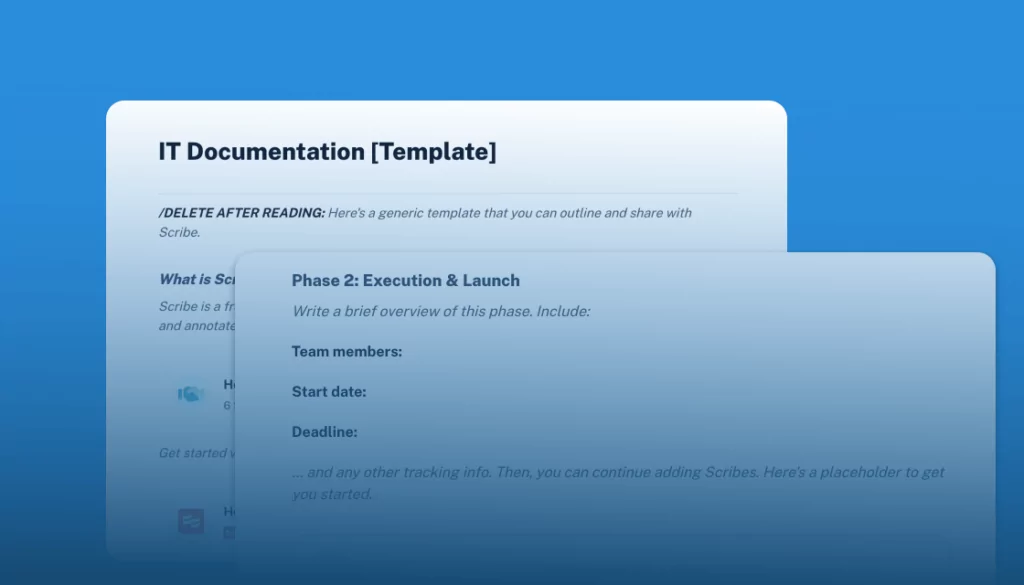What Is IT Documentation?
IT documentation encompasses all written materials and instructions central to system operations, procedures, configurations, and setups in an Information Technology (IT) environment. It serves as a reference point for IT professionals, facilitating system maintenance, troubleshooting, and operational consistency.
Effective documentation covers everything from network diagrams and hardware inventories to application dependencies and service records, ensuring comprehensive understanding and efficient management of IT resources.
Having accurate IT documentation significantly impacts the efficiency and reliability of IT operations. For example, documentation supports disaster recovery by providing clear guidelines and procedures, and streamlines everyday tasks by offering a centralized source of crucial information. This ensures that both new and existing staff have the necessary knowledge to efficiently manage and operate IT systems.
Benefits of IT Documentation
Comprehensive and well-maintained IT documentation provides numerous advantages for organizations:
- Streamlined Troubleshooting and Maintenance: Clear documentation ensures IT teams can quickly diagnose and resolve issues. Step-by-step guides and system details reduce downtime by providing immediate reference materials during critical incidents.
- Enhanced Knowledge Transfer: Well-structured documentation simplifies onboarding for new employees and ensures consistent knowledge sharing across the team, reducing dependency on individual expertise.
- Improved System Security and Compliance: Documentation helps organizations meet regulatory and legal requirements by maintaining a transparent record of system configurations, access controls, and data-handling procedures. It also strengthens security by detailing protocols for responding to incidents.
- Efficient Change Management: By documenting current configurations and dependencies, IT teams can better assess the impact of changes, minimizing disruptions and ensuring seamless updates or upgrades.
- Disaster Recovery Preparedness: Comprehensive documentation provides the foundation for effective disaster recovery. It includes recovery steps, backup schedules, and contact lists, enabling quicker restoration of services in emergencies.
- Resource Optimization: Accurate inventories of hardware, software, and licenses allow for better resource allocation and cost management. This prevents over-purchasing or underutilization of assets.
- Consistent IT Operations: A standardized approach to documentation helps ensure uniformity in IT processes, enabling teams to perform tasks consistently and according to best practices.
Key Types of IT Documentation
Network Documentation
Network documentation provides a comprehensive view of an organization’s networking environment, helping IT teams design, maintain, and secure network infrastructure.
Core elements:
Table of Contents
Toggle- Network Diagrams: Visual representations of network layouts, including routers, switches, firewalls, and other devices, showing their interconnections.
- IP Address Management: Detailed lists of assigned, reserved, and available IP addresses, ensuring efficient allocation and avoiding conflicts.
- Firewall and Security Policies: Definitions of access controls, rules, and protocols for securing the network.
- Bandwidth and Performance Metrics: Documentation of usage patterns, capacity planning, and performance benchmarks.
- Configuration Backups: Stored settings for critical devices to facilitate quick restoration in case of failure.
Infrastructure Documentation
Infrastructure documentation provides a detailed account of the physical and virtual resources that support IT systems. It enables proactive maintenance, scalability planning, and rapid troubleshooting of issues in complex environments.
Common components include:
- Topology Diagrams: Schematics illustrating the physical or virtual setup, including connections between components.
- Hardware Inventories: Detailed records of hardware, including make, model, location, and warranty information.
- Environment Configurations: Settings for development, staging, testing, and production environments to ensure consistent deployments.
- Maintenance Logs: Historical records of updates, repairs, and replacements for infrastructure components.
- Disaster Recovery Assets: Locations and configurations of backup hardware or failover systems.
System Documentation
System documentation provides a foundational understanding of IT systems, detailing their architecture, components, and functionality. It ensures IT teams can manage, troubleshoot, and expand systems effectively by having a clear reference.
Key elements include:
- System Overviews: High-level descriptions of a system’s purpose, key features, and functionality.
- Component Details: Specifics about hardware, software, databases, and integration points, including versioning information.
- Dependencies: Insights into how systems interact, such as API connections, shared resources, or data flows.
- Access Control: Definitions of user roles, permissions, and policies for securing sensitive information.
- Configuration Details: Documentation of settings and parameters critical to system performance.
Process Documentation
Process documentation outlines standardized workflows and ensures IT teams follow consistent procedures for routine and critical tasks. It reduces errors, supports training, and enables compliance with internal and external requirements.
Key inclusions:
- Step-by-Step Procedures: Instructions for performing system updates, deploying patches, or troubleshooting common issues.
- Escalation Paths: Clear routes for escalating unresolved problems, including contact details and criteria for escalation.
- Approval Workflows: Processes required for actions such as granting access, implementing changes, or approving purchases.
- Templates and Checklists: Predefined formats for reporting incidents, performing audits, or validating processes.
- Metrics for Evaluation: Defined performance indicators to assess the effectiveness of processes.
Support Documentation
Support documentation is designed to assist IT teams and helpdesk staff in resolving user issues efficiently and consistently. It serves as a critical tool for maintaining high-quality support services.
Examples include:
- Knowledge Base Articles: Comprehensive resources detailing solutions to common problems, categorized by topic or system.
- Troubleshooting Guides: Step-by-step instructions for diagnosing and resolving technical issues, with visual aids where possible.
- Escalation Guidelines: Detailed procedures for routing complex or unresolved issues to higher-tier support.
- SLAs and Expectations: Documentation of service-level agreements, including response times, uptime guarantees, and support commitments.
- User Feedback Loops: Processes for collecting and incorporating user feedback to improve support materials.
Technical Documentation
Technical documentation targets developers, engineers, and IT professionals, providing deep insights into system design, implementation, and maintenance. It bridges the gap between conceptual designs and operational execution.
Elements include:
- Code Repositories and APIs: Detailed explanations of source code functionality and API endpoints, including example requests and responses.
- Design Specifications: Comprehensive diagrams, flowcharts, and text-based descriptions of how systems are architected and interoperate.
- Testing Protocols: Procedures for unit, integration, and system testing, along with documented test cases and results.
- Deployment Guidelines: Instructions for deploying systems, including prerequisites, steps, and rollback procedures.
- Change Logs: Historical records of updates and modifications to systems or software.
Incident Response Documentation
Incident response documentation prepares IT teams to manage and resolve unexpected IT incidents effectively. It ensures swift and coordinated actions to minimize damage and downtime.
Essential inclusions:
- Incident Playbooks: Detailed action plans for responding to specific scenarios, such as data breaches, system outages, or malware attacks.
- Contact Lists: Comprehensive directories of internal and external stakeholders, including IT staff, legal counsel, and vendors.
- Communication Protocols: Predefined methods for notifying affected parties and coordinating responses.
- Forensic Guidelines: Steps for preserving evidence, analyzing the cause of incidents, and documenting findings.
- Post-Incident Reviews: Structured templates for reviewing incidents, identifying root causes, and recommending process improvements.
Compliance Standards for Technical Documentation
Here are some examples of established standards that provide industry guidance for IT documentation.
1. IEC/IEEE 82079-1
IEC/IEEE 82079-1 sets the criteria for creating clear, comprehensible, and accessible instruction manuals for any form of product or service. It emphasizes user-centered and safety-conscious documentation, aiming to ensure that users can perform intended operations correctly and safely.
The standard covers the structure, content, and presentation of instructions, stressing the importance of meeting users’ needs and abilities. Adhering to IEC/IEEE 82079-1 benefits organizations by enhancing the quality and effectiveness of their documentation. It reduces the risk of user error and improves satisfaction by providing clear and reliable guidance.
2. VDI Guideline 2770
VDI Guideline 2770 focuses on the digital delivery of technical documentation for equipment and products. It specifies requirements for document structures, formats, and metadata to ensure consistency and interoperability across different platforms and systems. The guideline aims to facilitate efficient, accurate documentation management and distribution.
Following VDI guideline 2770 allows organizations to streamline their documentation processes, improving access and readability while ensuring compatibility with various digital systems. This leads to better documentation practices, reducing time wasted on searching for information and enhancing operational efficiency.
3. ISO 2651x
The ISO 2651x series focuses on ergonomics in technical documentation, ensuring that information presented is user-friendly and easy to comprehend. It covers various aspects, including the design and presentation of information, to enhance readability and understanding. The goal is to ensure that users can effectively access and use the information, improving overall interaction with technical documents.
Adopting ISO 2651x series standards benefits organizations by making their documentation more accessible and user-centric. This leads to better user experiences, increased safety, and efficiency in performing tasks, contributing to greater satisfaction and productivity.
4. ISO/AWI 21999
ISO/AWI 21999 is a developing standard aimed at managing technical documentation over digital mediums. It focuses on the lifecycle of digital documents, including creation, management, distribution, and preservation. The standard seeks to ensure that documentation remains relevant, accessible, and secure throughout its digital lifecycle.

Lanir specializes in founding new tech companies for Enterprise Software: Assemble and nurture a great team, Early stage funding to growth late stage, One design partner to hundreds of enterprise customers, MVP to Enterprise grade product, Low level kernel engineering to AI/ML and BigData, One advisory board to a long list of shareholders and board members of the worlds largest VCs
Tips from the Expert
In my experience, here are tips that can help you better manage IT documentation:
-
Adopt a documentation framework
Use a structured framework (e.g., ITIL or ISO) to ensure your documentation is comprehensive and aligns with industry best practices, making it easier for teams to follow and update.
-
Implement role-based access
Restrict access to sensitive documentation using role-based permissions, ensuring only authorized personnel can modify critical system configurations or operational procedures.
-
Automate documentation updates
Utilize tools that automatically track and update system configurations, dependencies, and changes. This reduces manual effort and ensures real-time accuracy.
-
Create documentation templates
Standardize your documentation by creating reusable templates. This ensures consistency across all documents and makes it easier for IT staff to produce clear, organized content.
-
Incorporate real-time monitoring data
Integrate real-time monitoring tools with your documentation system to provide up-to-date insights on system health and performance, improving responsiveness to issues.
IT Documentation Best Practices
In addition to the industry standards above, here are some best practices you can easily implement to improve the effectiveness of IT documentation.
1. Use a Standardized Format for All Documents
Using a standardized format for all IT documentation ensures consistency and ease of understanding. This approach minimizes confusion, as users become familiar with the layout and know where to find specific information. Standardization promotes efficient information retrieval, saving time and reducing frustration for IT staff and end-users alike.
2. Ensure That Documentation Is Easily Accessible
The accessibility of IT documentation guarantees that crucial information is readily available when needed. It facilitates quick decision-making, problem-solving, and efficient system management. Accessibility can be achieved through well-organized digital repositories, intranet sites, or documentation management systems, ensuring that documents are searchable and retrievable.
3. Incorporate Diagrams, Flowcharts, and Screenshots
Visual aids such as diagrams, flowcharts, and screenshots make IT documentation more understandable and engaging. Visuals can simplify complex information, making it easier to grasp at a glance. They aid in explaining processes, layouts, and systems, providing a clear, visual representation that complements written descriptions.
Using visual aids enhances comprehension and retention of information. It caters to different learning styles, making documentation more inclusive and effective.
4. Implement a Version Control System to Track Changes
A version control system helps in tracking modifications made to IT documentation, ensuring integrity and accuracy over time. It allows for the maintenance of different documentation versions, providing visibility into changes and the ability to revert to previous versions if necessary.
Version control is crucial for managing document updates. It ensures that users always have access to the most current and correct information, and provides a clear audit trail of changes, supporting accountability and compliance.
5. Automate Documentation for System Dependencies
Creating documentation for system dependencies involves the use of tools and software to dynamically track and document the relationships and interactions between different applications, services, and systems within an IT environment. This process is crucial for understanding how different components rely on each other, ensuring that any changes or updates do not disrupt the overall system functionality.
Automated application dependency mapping tools enable quicker identification of potential issues and dependencies that could impact system performance or availability. It also supports better decision-making regarding system upgrades, migrations, and integrations by providing a comprehensive overview of how different components interact.
Automate IT Dependency Documentation with Faddom
Faddom is not a traditional IT documentation tool, but it can help provide accurate documentation of network topologies and assets in the IT environment. Faddom’s agentless IT discovery capabilities allow you to discover all IT assets such as servers and business applications, and gain visibility into your hybrid infrastructure.
Before you can work with the assets in your IT environment, it is first critical to discover and document everything. Even if teams have not taken the time to create comprehensive, written documentation, Faddom can perform discovery of IT assets without needing to integrate with other software. It does not merely repeat information from elsewhere—rather, it creates original IT documentation that is a single source of truth and is automatically updated.
Once Faddom is done mapping the environment, you can search for anything such as an IP, server, subnet, port, or host name to see all the cloud-based and on premises connections, dependencies, and installed software details. You can also map physical network devices such as switches and routers, and export all the information into formats such as VISIO, XLS, and CSV.
Learn more about Faddom for IT documentation or schedule a call with our expert team!








